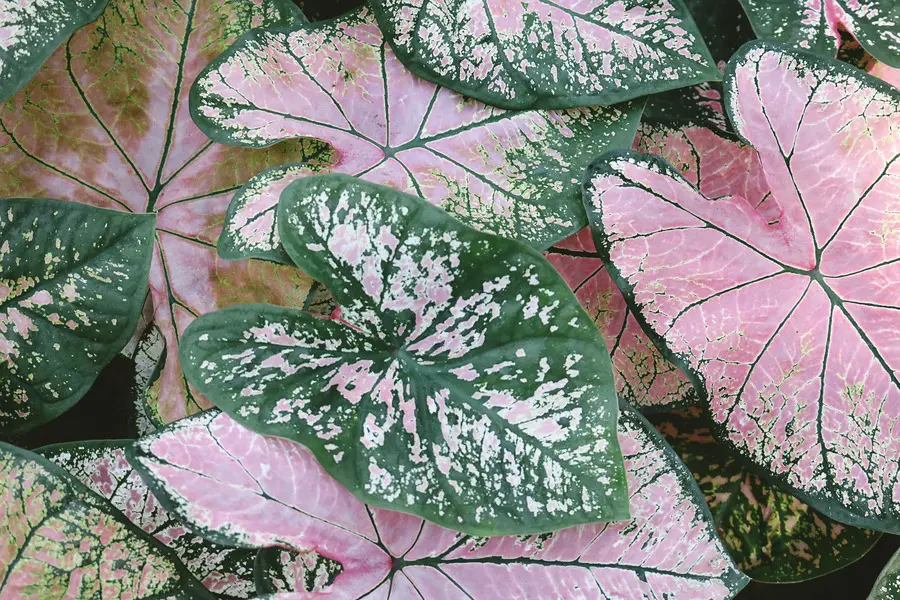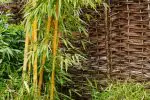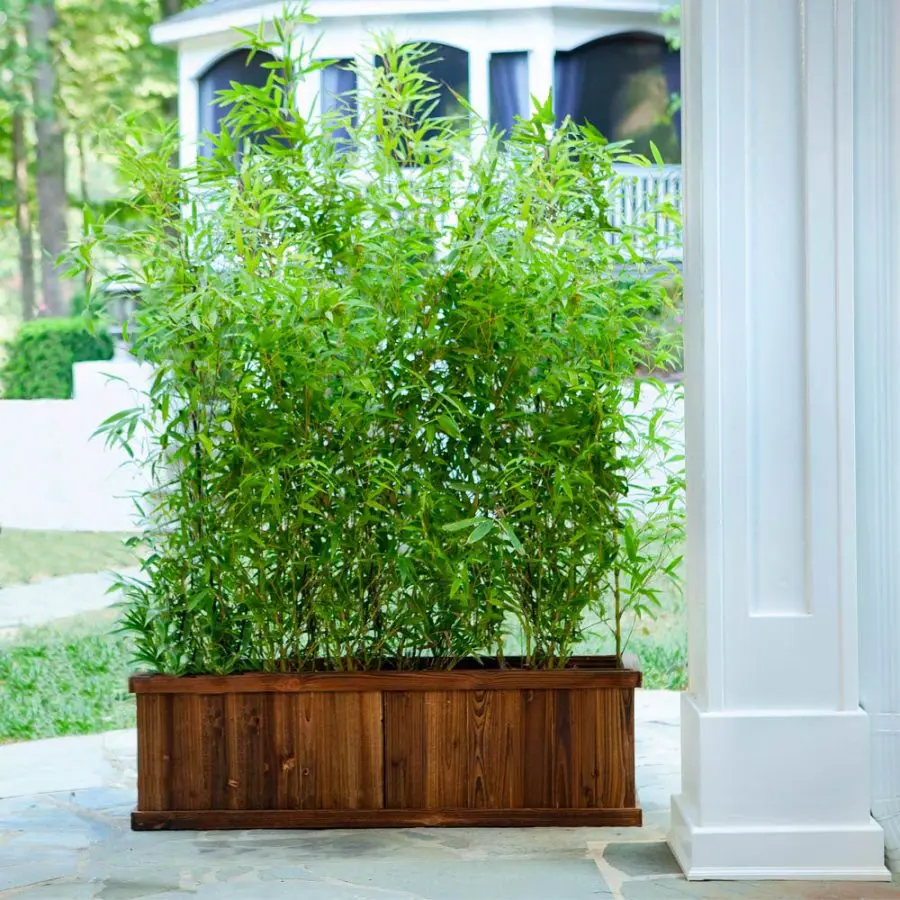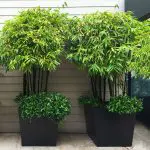This post contains affiliate links. If you buy something from one of our links we may earn a commission. Thanks

Discover growing Caladiums in pots indoors to brighten up your home with these easy tips! From light to watering, we’ve got you covered.
Growing Caladiums in pots indoors requires well-drained soil, indirect light, and high humidity. Place the pot in a warm area, away from direct sunlight, and keep the soil consistently moist. Fertilize every 4-6 weeks during the growing season. Reduce watering in winter when the plant goes dormant.
Looking for a beautiful and easy-to-care-for indoor plant? Look no further than the caladium! With their colorful and striking foliage, caladium plants are a great addition to any home.
While many gardeners are familiar with Caladiums in garden beds or in a shade garden not many realize they can also be grown indoors in pots.
Some gardeners in colder climates do lift bulbs before winter comes to save them for the following spring.
But why not pot some of them up and enjoy their bright leaf colors and large leaves all year long? Check out some Caladiums On Amazon
What Are Caladiums?
According to Wikipedia: Caladium is a genus of flowering plants in the family Araceae.
They are often known by the common name elephant ear (which they share with the closely related genera Alocasia, Colocasia, and Xanthosoma), heart of Jesus, and angel wings.
There are over 1000 named cultivars of Caladium bicolor from the original South American plant.
The genus Caladium includes seven species that are native to South America and Central America, and naturalized in India, parts of Africa, and various tropical islands.
They grow in open areas of the forest and on the banks of rivers and go dormant during the dry season.
The wild plants grow to 15–35 inches (40–90 cm) tall, with leaves mostly 6-18 inches (15–45 cm) long and broad.
In this guide, we’ll show you how to start growing Caladiums in pots indoors, so you can get the best results and enjoy their beauty year-round.
From finding the right pot to providing the right amount of light and water, we’ve got you covered. So let’s dive in and get started!
Growing Caladiums In Pots Indoors
Hey there plant lovers! Are you looking for a new addition to your indoor plant collection? Look no further than the caladium!
These stunning plants are also known as elephant ears and for their striking and colorful foliage, and they’re easy to care for too.
In this guide, we’ll show you everything you need to know about growing Caladiums in pots indoors.
Whether you’re a seasoned green thumb or a newbie, we’ve got you covered. So let’s dive in and learn how to keep your Caladiums looking their best!
Check out some Caladiums On Amazon
A brief overview of Caladiums
Why Caladiums are a popular indoor plant?
Caladiums are tropical plants that are native to South America. They are popular indoor plants because of their vibrant and colorful foliage, which comes in a range of shades and patterns.
These plants are relatively easy to care for and can be grown in pots indoors year-round, making them a great addition to any home.
Characteristics of Caladiums
Caladiums are known for their large, heart-shaped leaves that come in a variety of colors and patterns.
Some of the most popular varieties include those with pink and green leaves, red and green leaves, and white and green leaves.
These plants can grow to be up to three feet tall, but they can also be grown in smaller sizes for tabletop or shelf displays.
Caladium tubers or bulbs are used to grow these plants or you may purchase an established plant.
Benefits of Growing Caladiums In Pots Indoors
One of the biggest benefits of growing Caladiums in pots indoors is that they are relatively low-maintenance.
They do well in bright, indirect light and require regular watering, but they don’t need a lot of attention beyond that.
Additionally, these plants are known for their air-purifying qualities, which can help to improve the air quality in your home.
Popular Caladium Varieties
Caladiums come in a wide range of varieties, each with its own unique colors and patterns.
Some of the most popular varieties include the Pink Splash, which has bright pink leaves with green edges, and the White Christmas, which has white leaves with green veins.
Other popular varieties include the Red Flash, the Miss Muffet, and the Fannie Munson.
Overall, Caladiums are a great indoor plant choice for anyone looking to add some color and vibrancy to their home.
With a little bit of care and attention, these plants can thrive and provide you with years of enjoyment.
Fancy leaf Caladiums and strap leaf Caladiums
Fancy leaf Caladiums and strap leaf Caladiums are two popular types of Caladiums, known for their vibrant and colorful foliage.
Fancy leaf Caladiums have heart-shaped leaves with a pointed tip, and their foliage can come in a range of colors, including green, pink, red, and white.
The leaves often have a patterned appearance, with spots or streaks of contrasting colors.
Strap leaf Caladiums, on the other hand, have longer, narrower leaves that resemble straps or ribbons.
They are typically less showy than fancy leaf Caladiums, with foliage that is usually solid in color, often in shades of green or red.
Both types of Caladiums can make great houseplants, and they are often grown for their decorative foliage rather than for their flowers.
They thrive in warm, humid conditions, and with proper care, can provide a striking display of color and texture in your home or garden. Check out some Caladiums On Amazon
Choosing the Right Pot and Soil
When it comes to growing Caladiums in pots indoors, choosing the right pot and soil is essential for their health and growth.
Caladiums prefer well-drained soil that is rich in nutrients, and they need a pot that is large enough to accommodate their roots.
In this section, we’ll show you how to choose the right pot and soil for your Caladiums, so you can give them the best start possible. So let’s get started!
Best Potting Materials for Caladiums
When it comes to potting Caladiums, it’s important to choose a pot that has good drainage.
Terra cotta pots are a popular choice because they allow for air circulation and drainage.
Plastic pots can also work, but be sure to choose one with drainage holes in the bottom.
You can also add a layer of rocks or gravel to the bottom of your pot to aid in drainage.
How to Choose the Right Pot Size
Choosing the right pot size is essential for the health and growth of your Caladiums.
A pot that is too small can stunt their growth, while a pot that is too large can lead to overwatering and root rot.
A good rule of thumb is to choose a pot that is one size larger than the current pot your caladium is in.
This will give the roots room to grow without overwhelming them.
Ideal Soil Mix for Caladiums
Caladiums prefer moist soil that is rich in nutrients and organic matter and is well-draining.
A good soil mix for Caladiums is one that includes peat moss, perlite, and vermiculite.
This will provide the right balance of moisture retention and drainage, while also providing the nutrients your plants need to thrive.
You can also add a slow-release fertilizer to your soil mix to give your plants an extra boost of nutrients.
By choosing the right potting materials and soil mix, you can give your Caladiums the best start possible.
A well-draining pot and nutrient-rich soil will help to ensure that your plants grow strong and healthy, and provide you with beautiful foliage to enjoy for years to come.
Coco Coir and Perlite Potting Mix
Another popular potting mix for Caladiums is a combination of coco coir and perlite.
Coco coir is a sustainable and renewable alternative to peat moss and is known for its moisture retention and aeration properties.
Perlite, on the other hand, is a lightweight volcanic rock that provides excellent drainage.
When mixed together, coco coir and perlite create a well-draining soil mix that also retains moisture, making it a great option for Caladiums.
If you choose to use this potting mix, be sure to add a slow-release fertilizer to provide your plants with the necessary nutrients. Check out some Caladiums On Amazon
Light and Temperature Requirements
Caladiums are beautiful and vibrant indoor plants that have beautiful leaves that can add a pop of color to any room.
However, to keep your Caladiums looking their best, it’s important to give them the right amount of light and keep them at the right temperature.
In this section, we’ll go over the light and temperature requirements for Caladiums, so you can ensure that your plants thrive and bring you joy all year round.
So let’s dive in!
Ideal Temperature Range for Caladiums
Caladiums are tropical plants and prefer warm climates and temperatures. The ideal temperature range for Caladiums is between 65-85°F (18-29°C).
Anything below 60°F (15°C) can cause your Caladiums to become dormant, and temperatures above 90°F (32°C) can cause damage to the leaves.
So be sure to keep your Caladiums in a warm location and a stable environment.
Caladiums grow from a tuberous corm although they are often referred to as bulbs.
You want to provide a warm soil temperature, especially when starting these tubers or bulbs.
Best Location for Caladiums in Your Home
When it comes to the location of your Caladiums, it’s important to find a spot that provides the right amount of light and is free from drafts.
Avoid placing your Caladiums near windows or doors that are frequently opened, as this can cause temperature fluctuations and drafts.
Instead, opt for a spot that receives bright, indirect sunlight, such as a room with east or west-facing windows.
How to Provide the Right Amount of Light
Caladiums prefer bright, indirect light. Direct full sun can cause the leaves to burn, while too little light can cause the leaves to fade and lose their vibrant color.
A good rule of thumb is to place your Caladiums in a spot that receives bright, filtered light for at least 6 hours a day. They will do fine in partial shade too.
If you notice that your Caladiums are not getting enough light, you can supplement with a grow light to provide the necessary light for growth.
By providing your Caladiums with the right amount of light and keeping them in a warm and stable environment, you can ensure that your plants thrive and provide you with beautiful foliage to enjoy year-round.
Proper watering and humidity are key factors in the overall health of your Caladiums.
These beautiful tropical plants require consistent moisture and humidity levels to thrive.
In this section, we’ll cover everything you need to know about watering and humidity for your Caladiums, so you can keep them looking their best.
So let’s dive in!
Watering and Humidity
Proper watering and humidity are key factors in the overall health of your Caladiums.
These beautiful tropical plants require consistent moisture and humidity levels to thrive. In this section, we’ll cover everything you need to know about watering and humidity for your Caladiums, so you can keep them looking their best.
So let’s dive in!
How Much Water Caladiums Need
Caladiums prefer to be kept consistently moist, but not waterlogged.
Overwatering can lead to root rot and other issues, while underwatering can cause the leaves to wilt and droop.
As a general rule of thumb, water your Caladiums when the top inch of the soil surface feels dry to the touch.
Be sure to water thoroughly, allowing the water to drain out of the bottom of the pot.
Signs of Overwatering and Underwatering
It’s important to monitor your Caladiums for signs of overwatering and underwatering.
Overwatering can lead to yellowing leaves, root rot, and a musty smell.
Underwatering can cause the leaves to droop and curl and can lead to stunted growth. If you notice any of these signs, adjust your watering schedule accordingly.
How to Maintain the Right Humidity Level
Caladiums prefer high humidity levels, ideally between 60-80%.
To maintain the right humidity level, you can place a humidifier near your plants, or group them together to create a microclimate.
You can also place a tray of water near your plants to increase the humidity in the surrounding area.
You can also mist your Caladiums with a spray bottle and they will appreciate the increased humidity. Another option is adding a small humidifier to the room.
By providing your Caladiums with the right amount of water and humidity, you can ensure that your plants remain healthy and vibrant.
Keep an eye on your plants and adjust your watering and humidity levels as needed to keep them thriving.
Fertilizing Caladiums
To keep your Caladiums looking their best, it’s important to provide them with the right nutrients.
In this section, we’ll talk about the best fertilizers for Caladiums, when to fertilize them, and how to apply fertilizer.
With a little bit of know-how, you can ensure that your Caladiums get the nutrients they need to grow and thrive.
So let’s dive in and learn about fertilizing Caladiums!
Check out some Caladiums On Amazon
Importance of Fertilizing Caladiums
Fertilizing is an important aspect of caring for Caladiums.
By providing your plants with the right nutrients, you can encourage healthy growth and vibrant foliage.
Fertilizing can also help prevent nutrient deficiencies, which can cause yellowing leaves and other issues.
Best Fertilizer for Caladiums
When it comes to fertilizing Caladiums, it’s important to choose a fertilizer that is high in nitrogen.
Nitrogen is essential for foliage growth, which is what Caladiums are prized for.
A balanced liquid fertilizer can work well. You can also use a slow-release fertilizer, which will gradually release nutrients over time. Slow-release fertilizer spikes work well for this.
How Often to Fertilize
Caladiums should be fertilized every 4-6 weeks during the growing season, which is typically from spring to fall.
Be sure to follow the instructions on the fertilizer packaging, as different fertilizers may have different application rates.
It’s also important not to over-fertilize, as this can lead to burnt foliage and other issues.
By fertilizing your Caladiums regularly, you can ensure that they receive the nutrients they need to grow and thrive.
Be sure to choose a fertilizer that is high in nitrogen, and fertilize your plants every 4-6 weeks during the growing season.
With a little bit of care, your Caladiums will reward you with beautiful foliage and vibrant colors.
Preventing and Treating Pests and Diseases
Just like any other houseplant, Caladiums are susceptible to pests and diseases.
In this section, we’ll discuss the most common pests and diseases that can affect your Caladiums, how to identify them, and what you can do to prevent and treat them.
By being vigilant and taking steps to keep your Caladiums healthy, you can enjoy their beauty for years to come.
So let’s dive in and learn about preventing and treating pests and diseases in Caladiums!
Common Pests and Diseases that Affect Caladiums
Caladiums are prone to a variety of pests and diseases, including spider mites, aphids, mealybugs, scale insects, and fungal diseases such as leaf spot and root rot.
These pests and diseases can cause damage to the foliage, stunting of growth, and even death of the plant.
How to Identify and Treat Pests and Diseases
It’s important to keep a watchful eye on your Caladiums for any signs of pests or diseases.
Symptoms of pest infestations can include distorted foliage, webbing, and tiny insects on the leaves.
Symptoms of fungal diseases can include yellowing or browning of leaves, black spots on foliage, and wilting.
If you do notice signs of pests or diseases, it’s important to take action as soon as possible.
There are a variety of treatments available, including insecticidal soaps, neem oil, and fungicides.
Be sure to follow the instructions on the packaging carefully, and always wear protective gear such as gloves and a mask when applying these treatments.
Tips for Preventing Pests and Diseases
Preventing pests and diseases is always better than trying to treat them.
To keep your Caladiums healthy, be sure to keep them in a well-ventilated area with good air circulation.
Water your plants properly, being careful not to overwater, which can create conditions that are ideal for fungal growth.
Regularly inspect your plants for any signs of pests or diseases, and take action immediately if you do notice any problems.
You can also use preventative treatments such as neem oil or insecticidal soaps to help keep pests at bay.
By taking steps to prevent and treat pests and diseases, you can keep your Caladiums healthy and thriving.
Be sure to keep a watchful eye on your plants, and take action as soon as you notice any signs of problems.
With a little bit of care and attention, you can enjoy beautiful, healthy Caladiums for years to come.
Repotting Caladiums
Check out some Caladiums On Amazon
Congratulations! You’ve been successfully caring for your Caladiums and now it’s time to think about repotting them.
Repotting is an essential step to ensure your plant’s continued health and growth.
In this section, we’ll go over everything you need to know about repotting Caladiums, from when to do it to how to do it right. So let’s get started!
When to Repot Caladiums
Knowing when to repot your caladium is important for their overall health and growth.
If you notice the roots starting to grow out of the drainage holes, it’s time to repot. The best time to do this is in the spring, just before the growing season starts.
How to Repot Caladiums
To repot your caladium, start by gently removing it from the current pot. Then, loosen up the roots and remove any dead or damaged ones.
Next, choose a slightly larger pot and fill the bottom with fresh potting mix.
Place the plant in the center and add more potting mix around the roots. Be sure to water thoroughly after repotting.
Tips for Maintaining Healthy Roots
To maintain healthy roots, make sure the new pot has good drainage and use a well-draining potting mix.
Don’t overwater your plant, as this can lead to root rot. Also, be sure to give your plant enough light and fertilize it regularly to encourage healthy growth.
Propagating Caladiums
Caladiums can be propagated by dividing their bulbs, which can multiply over time.
When the plant becomes overcrowded, the bulbs can be removed, separated, and replanted to create new plants.
To divide the bulbs, carefully remove the plant from its pot and gently separate the bulbs from the roots.
Be sure to keep some of the roots attached to each bulb. You can also carefully slice the bulbs into sections with a sharp, clean knife, making sure each section has at least one healthy bud.
Once you have divided the bulbs, plant them in fresh potting mix in a new pot.
Water the soil well and place the pot in a bright, indirect light location. Keep the soil consistently moist and warm until the new plants establish roots and begin to grow.
It’s important to note that not all caladium bulbs will replicate, as some may not produce new buds or may be weaker than others.
It’s always best to propagate healthy and strong bulbs to ensure the success of your new plants.
Displaying Caladiums and Using Their Cut Flowers
While Caladiums are primarily grown for their brightly colored foliage they do make spathe-like flowers too. They are long-lasting and can be used in floral arrangements.
When arranging Caladiums with other flowers, consider pairing them with flowers that complement their color and texture.
For example, the bright pink and green leaves of a caladium would look lovely alongside white roses or peonies.
Alternatively, you could create a monochromatic arrangement using different shades of caladium leaves.
To prolong the life of cut Caladiums, make sure to change the water in the vase daily and trim the stems every few days.
You can also add flower food to the water to help nourish the plant.
Finally, consider using Caladiums in creative ways beyond the traditional vase.
For example, you could create a wreath using fresh caladium leaves and other foliage. T
his unique and eye-catching display would make a great statement piece in your home.
Where and how to display caladium pots indoors
Caladiums are stunning indoor plants that can brighten up any room in your home. Here are some tips on where and how to display caladium pots indoors:
Choose the right location: Caladiums thrive in bright, indirect light, so choose a spot in your home that gets plenty of natural light but is not in direct sunlight. A north-facing window is an ideal spot for a caladium pot.
Consider the temperature: Caladiums prefer temperatures between 65-75°F (18-24°C), so make sure to keep them away from cold drafts or hot air vents.
Use the right pot: Caladiums prefer pots with good drainage holes to prevent the soil from becoming waterlogged. Choose a pot that is slightly larger than the plant’s root ball to give the roots room to grow.
Add some color: Caladiums come in a range of colors, from bright pinks and reds to soft greens and whites. Consider the color scheme of the room where you’ll be displaying your caladium pot and choose a plant with colors that complement your decor.
Create a group display: Consider grouping several caladium pots together to create a lush and vibrant display. Use pots of varying heights and colors to add interest and texture.
Add a decorative touch: Consider adding a decorative touch to your caladium pot display, such as a colorful saucer or decorative pebbles. This will not only add visual interest but can also help retain moisture and maintain humidity levels around the plant.
Overall, Caladiums are versatile indoor plants that can be displayed in a variety of ways to brighten up your home.
With proper care and attention, your caladium pots will thrive and provide you with years of enjoyment.
Caladium FAQs
Caladiums are popular houseplants known for their colorful foliage, and many people have questions about their indoor care.
Their unique leaves make them an appealing option for adding a splash of color to indoor spaces.
From sunlight requirements to long-term care, here’s what you need to know in a quick Q&A format.
Q: How do you care for caladiums in pots indoors?
A: Use well-drained soil and keep the plant in indirect light. Water regularly, but don’t let the soil get soggy. Fertilize every 4-6 weeks during the growing season.
Q: Can you keep caladiums indoors all year?
A: Yes, you can keep caladiums indoors all year. However, they usually go dormant in winter, so reduce watering and stop fertilizing during this period.
Q: Where should I place my Caladium indoors?
A: Place your Caladium in a warm spot with indirect sunlight. Too much direct light can fade the leaf colors.
Q: Do caladiums do well indoors?
A: Caladiums can thrive indoors with proper care. They prefer high humidity, so consider placing a humidifier nearby or misting the leaves occasionally.
Growing Caladiums In Pots Indoors Final Thoughts
In conclusion, caring for Caladiums in pots indoors is an enjoyable and rewarding experience.
By following these simple tips, you can keep your Caladiums looking beautiful and healthy all year round.
Remember to choose the right pot and soil, provide adequate lighting and temperature, water and fertilize appropriately, and keep an eye out for pests and diseases.
With a little bit of attention and care, your Caladiums will thrive and bring joy to your home. Happy planting!
Key takeaways on caring for growing Caladiums in pots indoors:
• Choosing the right pot and soil is important for the health of your Caladiums. Consider using a pot that allows for proper drainage and a well-draining soil mix.
• Caladiums require the right amount of light and temperature to thrive. They prefer bright, indirect light and a temperature range of 65-80°F.
• Proper watering and humidity are crucial for healthy Caladiums. Avoid overwatering and maintain a humidity level of at least 50%.
• Fertilizing your Caladiums can promote growth and healthy foliage. Use a balanced, water-soluble fertilizer every 4-6 weeks during the growing season.
• Keep an eye out for common pests and diseases that can affect your Caladiums, and take measures to prevent or treat them.
Overall, caring for Caladiums in pots indoors can be a fun and rewarding experience. By following these tips, you can keep your Caladiums looking beautiful and healthy. Remember to give them the right amount of light, water, and nutrients, and keep them away from direct sunlight and drafts. With a little bit of love and attention, your Caladiums will thrive and add beauty to your home.
Check out some Caladiums On Amazon
Read more about the 20 Benefits Of Keeping Indoor Plants



















